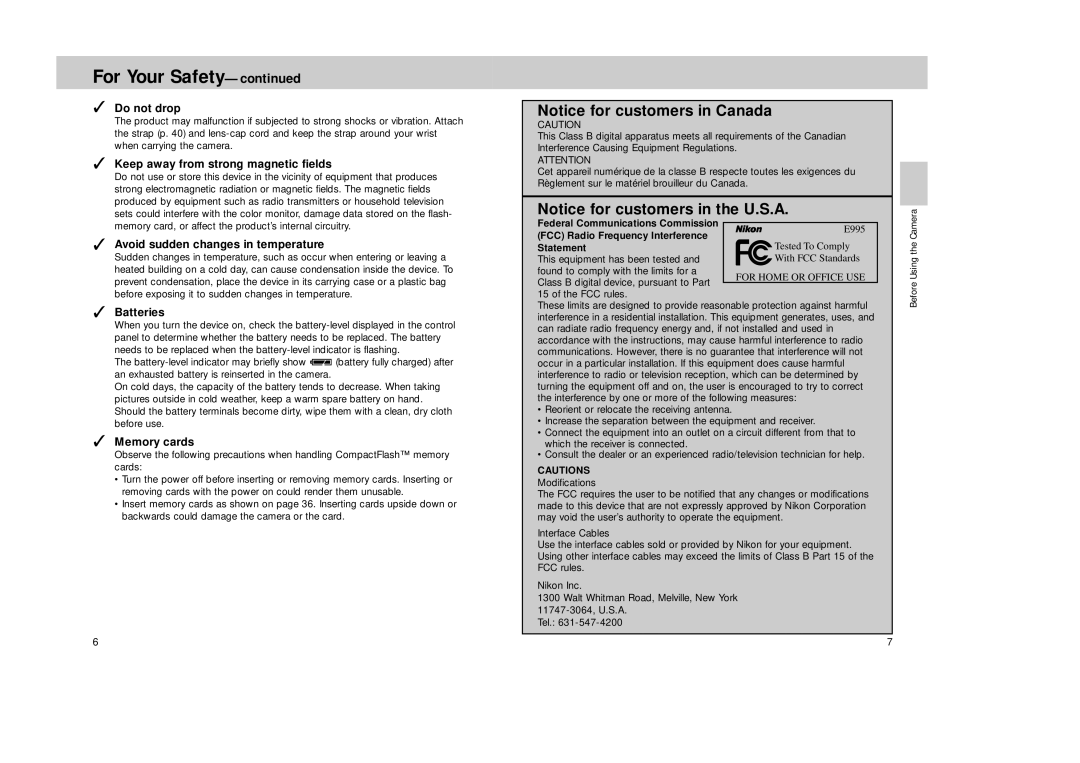
For Your Safety—continued
Do not drop
The product may malfunction if subjected to strong shocks or vibration. Attach the strap (p. 40) and
Keep away from strong magnetic fields
Do not use or store this device in the vicinity of equipment that produces strong electromagnetic radiation or magnetic fields. The magnetic fields produced by equipment such as radio transmitters or household television sets could interfere with the color monitor, damage data stored on the flash- memory card, or affect the product’s internal circuitry.
Avoid sudden changes in temperature
Sudden changes in temperature, such as occur when entering or leaving a heated building on a cold day, can cause condensation inside the device. To prevent condensation, place the device in its carrying case or a plastic bag before exposing it to sudden changes in temperature.
Batteries
When you turn the device on, check the
The
On cold days, the capacity of the battery tends to decrease. When taking pictures outside in cold weather, keep a warm spare battery on hand. Should the battery terminals become dirty, wipe them with a clean, dry cloth before use.
Memory cards
Observe the following precautions when handling CompactFlash™ memory cards:
•Turn the power off before inserting or removing memory cards. Inserting or removing cards with the power on could render them unusable.
•Insert memory cards as shown on page 36. Inserting cards upside down or backwards could damage the camera or the card.
6
Notice for customers in Canada
CAUTION
This Class B digital apparatus meets all requirements of the Canadian Interference Causing Equipment Regulations.
ATTENTION
Cet appareil numérique de la classe B respecte toutes les exigences du Règlement sur le matériel brouilleur du Canada.
Notice for customers in the U.S.A.
Federal Communications Commission
(FCC) Radio Frequency Interference
Statement
This equipment has been tested and found to comply with the limits for a Class B digital device, pursuant to Part 15 of the FCC rules.
These limits are designed to provide reasonable protection against harmful interference in a residential installation. This equipment generates, uses, and can radiate radio frequency energy and, if not installed and used in accordance with the instructions, may cause harmful interference to radio communications. However, there is no guarantee that interference will not occur in a particular installation. If this equipment does cause harmful interference to radio or television reception, which can be determined by turning the equipment off and on, the user is encouraged to try to correct the interference by one or more of the following measures:
•Reorient or relocate the receiving antenna.
•Increase the separation between the equipment and receiver.
•Connect the equipment into an outlet on a circuit different from that to which the receiver is connected.
•Consult the dealer or an experienced radio/television technician for help.
CAUTIONS
Modifications
The FCC requires the user to be notified that any changes or modifications made to this device that are not expressly approved by Nikon Corporation may void the user’s authority to operate the equipment.
Interface Cables
Use the interface cables sold or provided by Nikon for your equipment. Using other interface cables may exceed the limits of Class B Part 15 of the FCC rules.
Nikon Inc.
1300 Walt Whitman Road, Melville, New York
Tel.:
7
Before Using the Camera
